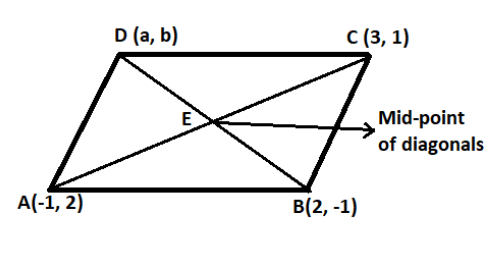
If (– 1, 2), (2, –1) and (3, 1) are any three vertices of a parallelogram then find the fourth vertex (a, b).
Answer
603.3k+ views
Hint: Let us use the property of parallelogram that diagonals of a parallelogram intersect each other at mid-point. Then use the midpoint theorem for both diagonals and get the solution.
Complete step-by-step answer:

Let ABCD be the given parallelogram drawn above. So, we had to find the coordinates of point D.
Now as we know from the property of parallelogram that both the diagonals of parallelogram intersect each other at the midpoint of the diagonal.
So, from the above figure we can see that point E will be the midpoint of diagonal AC and diagonal BD.
As we know that if P\[\left( {{{\text{x}}_1},{{\text{y}}_1}} \right)\] and Q\[\left( {{{\text{x}}_2},{{\text{y}}_2}} \right)\] are the two points then the coordinates of the midpoint of line segment PQ will be R\[\left( {\dfrac{{\left( {{{\text{x}}_1} + {{\text{x}}_2}} \right)}}{2},\dfrac{{\left( {{{\text{y}}_1} + {{\text{y}}_2}} \right)}}{2}} \right)\].
And, E is the midpoint of AC. So, coordinates of E will be \[\left( {\dfrac{{\left( { - 1 + 3} \right)}}{2},\dfrac{{\left( {2 + 1} \right)}}{2}} \right)\] = \[\left( {\dfrac{2}{2},\dfrac{3}{2}} \right)\]
Now E is also the mid-point of diagonal BD. So, coordinates of E will be \[\left( {\dfrac{{\left( {2 + {\text{a}}} \right)}}{2},\dfrac{{\left( { - 1 + {\text{b}}} \right)}}{2}} \right)\]
As we know that coordinates of point E will be the same in both cases.
So, \[\left( {\dfrac{2}{2},\dfrac{3}{2}} \right)\] = \[\left( {\dfrac{{\left( {2 + {\text{a}}} \right)}}{2},\dfrac{{\left( { - 1 + {\text{b}}} \right)}}{2}} \right)\]
So, comparing x and y coordinates from the above equation. We get,
\[\dfrac{2}{2} = \dfrac{{\left( {2 + {\text{a}}} \right)}}{2}\] and \[\dfrac{3}{2} = \dfrac{{\left( { - 1 + {\text{b}}} \right)}}{2}\]
From the above equation. We get,
a = 0 and b = 4
So, coordinates of point D will be (0, 4)
Hence, the fourth side of the given parallelogram will be (0, 4).
Note: Whenever we come up with this type of question then the easiest and efficient way to find the coordinates of the fourth point will be by using the midpoint theorem we can find the midpoint of both the diagonals and then compare them to get the required value of a and b.
Complete step-by-step answer:

Let ABCD be the given parallelogram drawn above. So, we had to find the coordinates of point D.
Now as we know from the property of parallelogram that both the diagonals of parallelogram intersect each other at the midpoint of the diagonal.
So, from the above figure we can see that point E will be the midpoint of diagonal AC and diagonal BD.
As we know that if P\[\left( {{{\text{x}}_1},{{\text{y}}_1}} \right)\] and Q\[\left( {{{\text{x}}_2},{{\text{y}}_2}} \right)\] are the two points then the coordinates of the midpoint of line segment PQ will be R\[\left( {\dfrac{{\left( {{{\text{x}}_1} + {{\text{x}}_2}} \right)}}{2},\dfrac{{\left( {{{\text{y}}_1} + {{\text{y}}_2}} \right)}}{2}} \right)\].
And, E is the midpoint of AC. So, coordinates of E will be \[\left( {\dfrac{{\left( { - 1 + 3} \right)}}{2},\dfrac{{\left( {2 + 1} \right)}}{2}} \right)\] = \[\left( {\dfrac{2}{2},\dfrac{3}{2}} \right)\]
Now E is also the mid-point of diagonal BD. So, coordinates of E will be \[\left( {\dfrac{{\left( {2 + {\text{a}}} \right)}}{2},\dfrac{{\left( { - 1 + {\text{b}}} \right)}}{2}} \right)\]
As we know that coordinates of point E will be the same in both cases.
So, \[\left( {\dfrac{2}{2},\dfrac{3}{2}} \right)\] = \[\left( {\dfrac{{\left( {2 + {\text{a}}} \right)}}{2},\dfrac{{\left( { - 1 + {\text{b}}} \right)}}{2}} \right)\]
So, comparing x and y coordinates from the above equation. We get,
\[\dfrac{2}{2} = \dfrac{{\left( {2 + {\text{a}}} \right)}}{2}\] and \[\dfrac{3}{2} = \dfrac{{\left( { - 1 + {\text{b}}} \right)}}{2}\]
From the above equation. We get,
a = 0 and b = 4
So, coordinates of point D will be (0, 4)
Hence, the fourth side of the given parallelogram will be (0, 4).
Note: Whenever we come up with this type of question then the easiest and efficient way to find the coordinates of the fourth point will be by using the midpoint theorem we can find the midpoint of both the diagonals and then compare them to get the required value of a and b.
Recently Updated Pages
Master Class 12 Business Studies: Engaging Questions & Answers for Success

Master Class 12 Economics: Engaging Questions & Answers for Success

Master Class 12 English: Engaging Questions & Answers for Success

Master Class 12 Maths: Engaging Questions & Answers for Success

Master Class 12 Social Science: Engaging Questions & Answers for Success

Master Class 12 Chemistry: Engaging Questions & Answers for Success

Trending doubts
Which places in India experience sunrise first and class 9 social science CBSE

Fill the blanks with the suitable prepositions 1 The class 9 english CBSE

Write the 6 fundamental rights of India and explain in detail

Difference Between Plant Cell and Animal Cell

What is pollution? How many types of pollution? Define it

What is the full form of pH?




